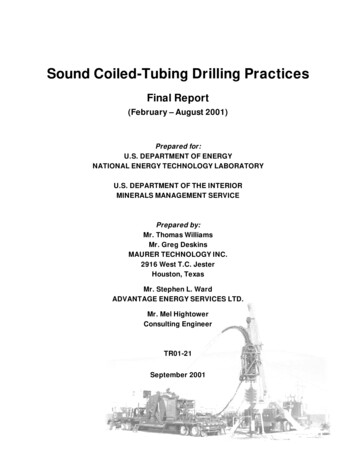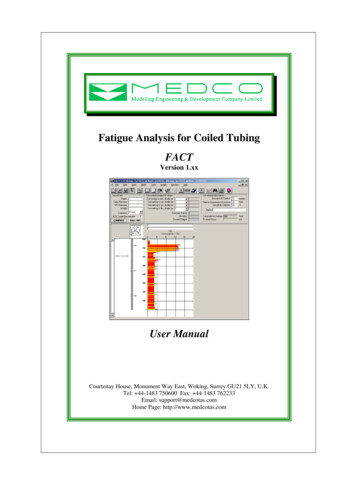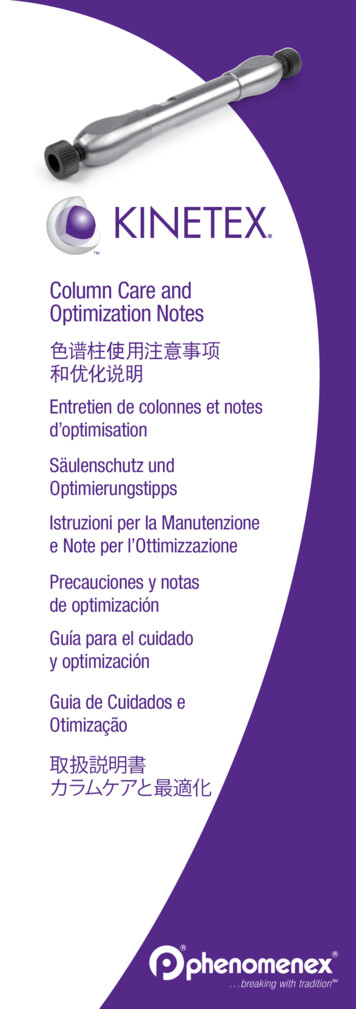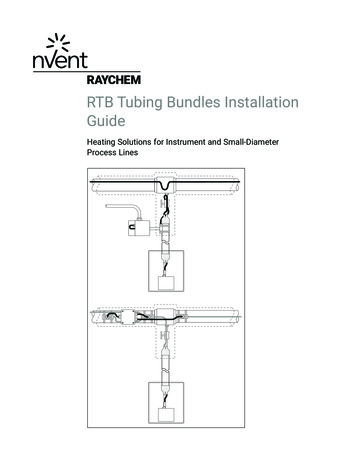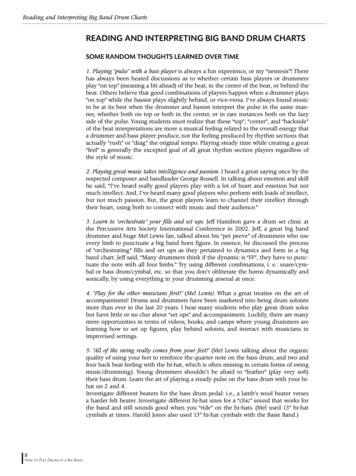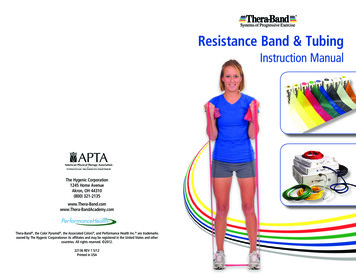
Transcription
Resistance Band & TubingInstruction ManualThe Hygenic Corporation1245 Home AvenueAkron, OH 44310(800) m Thera-Band , the Color Pyramid , the Associated Colors , and Performance Health Inc. are trademarksowned by The Hygenic Corporationor its affiliates and may be registered in the United States and othercountries. All rights reserved. 2012.22136 REV 1 5/12Printed in USA
Instruction ManualTable of ContentsIntroduction. . . . . . . . . . . . . . . . . . . . . . . . . . . . . . . . . . . . . . . . . . . 2Information for Healthcare Professionals. . . . . . . . . . . . . . . . . . 3Information for Patients and Consumers. . . . . . . . . . . . . . . . . . 4Practical Exercise Tips . . . . . . . . . . . . . . . . . . . . . . . . . . . . . . . . . 5Caring for Elastic Bands and Tubing. . . . . . . . . . . . . . . . . . . . . . 5Directions for Handling, Connecting, and SecuringThera-Band Resistance Bands and Tubing. . . . . . . . . . . . . . . . 6Exercise Resistance Pull Force Charts. . . . . . . . . . . . . . . . . . . 11Exercise Dosage. . . . . . . . . . . . . . . . . . . . . . . . . . . . . . . . . . . . . . 13Outcomes . . . . . . . . . . . . . . . . . . . . . . . . . . . . . . . . . . . . . . . . . . . 14Exercise List Summary. . . . . . . . . . . . . . . . . . . . . . . . . . . . . . . . 15Exercise Illustrations. . . . . . . . . . . . . . . . . . . . . . . . . . . . . . . . . . 16www.Thera-BandAcademy.com. . . . . . . . . . . . . . . . . . . . . . . . . 401
Instruction ManualInstruction ManualIntroductionInformation for Healthcare Professionalsecognized as the original system of progressive resistance for over 25 years,Thera-Band elastic resistance has been proven to increase strength, mobilityand function, as well as reduce joint pain1, 2, 3. Evidence-based exercise programsutilizing Thera-Band bands and tubing rehabilitate injuries, improve the functionalability of older adults, improve athletic performance, and aid in treating many chronicdiseases.Thera-Band resistance bands and tubing are low-cost, portable and versatile.Made of natural rubber latex, they are easily recognized by the trademarkThera-Band colors – Tan, Yellow, Red, Green, Blue, Black, Silver and Gold.Advancing through the sequential system of progressive resistance provides positivereinforcement and feedback for gauging results.The progressive resistance levels speak of success; the colors tell you it’sThera-Band .IndicationsR* Bands onlyFor those who have allergies to latex, Thera-Band Latex Free Resistance Bandsprovide the same benefits as regular bands.1.2.3.Jette AM et al. 1999. Exercise—It’s never too late: The Strong for Life Program.Am J Public Health: 89(1):66-72.Mikesky AE et al. 1994. Efficacy of a home-based training program for older adultsusing elastic tubing. Europ J Appl Physiol : 69:316-320.Topp R. et al. 2002. The effect of dynamic versus isometric resistance training on pain andfunctioning among adults with osteoarthritis of the knee. Arch Phys Med Rehabil: 83:1187-1195.For a comprehensive database of references,visit www.Thera-BandAcademy.com/research.2In addition to general wellness and fitness programs, elastic resistanceis indicated for use in a variety of impairments: Resistance training forPostural impairmentsMotor function impairmentsMuscle performance impairments Stretching exercises for muscle length impairments Balance training for balance and gait impairments Cardio training for cardiorespiratory impairments Functional and sport-specific training for functional limitationsProduct Safety Use of any products described in this manual can cause serious injury whennot used properly. Healthcare professionals are advised to prescribe onlythose exercises deemed safe for their patients.For patients using the bands or tubing as part of a home therapy program,it is imperative to instruct the patient on safe and proper use of the bandsor tubing to avoid injury.Patients with latex allergies or sensitvities should use Thera-Band Latex-Free resistance bands.Avoid choosing bands and tubing that are too short. Healthcare professionalsshould ensure adequate length of the band to avoid overly high pull forcesand to provide more user control.Avoid exercises that involve stretching the Thera-Band resistance band ortube in such a fashion that it may snap toward the head and cause injuryto the head or eyes. Protective eye wear should be worn if performingthis type of exercise.Always examine the resistive band or tube before use for small nicks, tears,or punctures that may cause the band to break. If you find any flaws, discardthe product and replace before performing any exercises.Be sure the resistance band or tubing is securely anchored to a sturdy objector attachment before using.Do not stretch bands or tubing by more than 3 times its restinglength. Example: a 12” (30 cm) band should not be stretched to morethan 36” (90 cm) total length.3
Instruction ManualInformation for Patients and ConsumersPrecautions 4Always consult your physician before beginning an exercise program.Your rehabilitation or exercise professional should help develop anindividualized program to meet your needs and abilities.Use of any products described in this manual can cause serious injury whennot used properly.Patients with latex allergies or sensitives should use Thera-Band Latex-Freeresistance bands.Avoid exercises that involve stretching the Thera-Band resistance bandsor tubing in such a fashion that they may snap toward the head and causeinjury to the head or eyes. If these types of exercises are prescribed,protective eyeware should be worn.Thera-Band resistance bands and tubing are not toys; consult a physicianbefore allowing children to exercise. Do not permit children to use withoutproper supervision.If you experience sharp pain, shortness of breath, dizziness or light-headedness with any of these exercises, stop immediately and contact yourhealthcare provider.As with any exercise program, muscle soreness may be experienced over thefirst few days. If your pain should persist for more than 3 or 4 days, consultyour physician or therapist. Do not exercise while experiencing pain.Be sure the resistance band or tubing is securely anchored to a sturdy objector attachment before using.Do not overstretch the resistance band or tube by more than 3 timesits resting length. Example: a 12” (30 cm) band should not be stretchedto more than 36” (90 cm) total length.Protect the Thera-Band resistance band or tubing by keeping it away fromsharp objects. Remove rings from the fingers before using the resistancebands or tubing. Be aware of long, sharp fingernails.Instruction ManualPractical Exercise Tips With all exercises, posture and body alignment is critical. Keep the shouldersand hips aligned, tighten the abdominals, and relax the knees. Be sure topractice the safest posture possible by maintaining a natural spinal curve.Use the band or tubing prescribed by your physician or therapist for theprescribed sets and repetitions. Rest between sets.Include proper warm-up and cool-down activities with your elasticresistance training program.Perform all exercises in a slow and controlled manner. At no time shouldyou feel “out of control”; remember to control the band or tubing rather thanallowing it to control you. Do not allow the band or tubing to snap back.Avoid hyperextending or over-flexing joints when exercising. Don’t lockthe joints.Breathe evenly while performing your exercises. Exhale during the moredifficult phase of the repetition. Don’t hold your breath.For beginners, perform the exercises without the band or tubing until youare comfortable, then add resistance. Begin with 8 to 10 exercises that targetmajor muscle groups.Exercise with the level of band that was prescribed for you, or with a levelthat allows you to complete 2 to 3 sets of 10 to 15 repetitions with mildfatigue on the last set.Progress to the next level band when you are able to easily completethe 3 sets of 10 to 15 repetitions.Caring for Elastic Bands and Tubing Always examine the resistance band or tubing before use for small nicks,tears, or punctures that may cause the band to break. If you find any flaws,discard the product and replace before performing any exercises.Store all resistance bands and tubing out of direct sunlight and away fromextreme temperatures.After use in chlorinated water, rinse the bands or tubing with tap waterand dry flat.If the bands or tubing becomes sticky, clean with mild soap and water,dry flat, and then dust with talcum powder, baby powder or corn starch.5
Instruction ManualDirections for Handling, Connecting, and SecuringThera-Band Resistance Bands and TubingInstruction ManualCreating LoopsLoops can be easily created for upper or lower body exercises.Always examine your band or tubing before use; discard and replace if you notice anytears or nicks. Protect the eyes during exercises that may cause the band or tubingto snap back toward the head. Check routinely for evidence of wear of the band ortubing at connection points and replace the band if evidence is found.Handling the BandsYour elastic band or tubing should be securely attached to your hand or foot beforeuse to avoid slippage and possible injury. “Double wrapping” the band may helpsecure it to your hand or foot. Never exercise with the band or tubing unless it issecured properly.Grip WrapLay the band flat in your hand with the end toward your pinky finger. Wrap the longend of the band around the back ofyour hand. Repeat as needed.Firmly grasp.Short length loop: Tie eachend into a square knot.Long length loop: Tie endstogether in a simple knot, leavinglong loop.Using Bands for Lower BodyPalm WrapBegin with palms up and ends of band betweenthe thumb and palm. Rotate your palms inward,bringing the band around the back of your hands.Repeat as needed. Firmly grasp.Euro WrapBegin with your palm facing forward andthe ends of the band between the thumband palm. Rotate your arm inward. Turnyour hand downward, bringing the bandaround the back of your hand. Returnthe palm facing forward, bringing theband between the thumb and fingers.6Foot Loop: Stand on the middle of theband. Loop over the top of the foot andstabilize other ends with opposite foot.Foot Wrap: Stand on the middleof the band. Wrap one end aroundthe top of the foot.Ankle Wrap: Place the back of your ankle in the middle ofthe band. Cross the ends in front of your ankle and bringthem down on the sides of the ankle. Cross the ends underthe foot and bring up around the sides.7
Instruction ManualHandling the TubingInstruction ManualUsing Elastic Resistance AccessoriesAccessories can also be used to connect or secure elastic resistance. Accessoriesinclude handles, door anchors, extremity straps, sports handles, and Assist straps.Monitor the attachment periodically for slippage and tighten as necessary.Looped Handle: Begin by wrapping the tubing around the palm to determine the sizeof the loop. Make a loop by crossing the tubing over and around, pulling the endthrough the hole. Be sure the loops are tight and secure before using the tubing.Repeat on the other end of tubing.Place entire hand throughthe tubing loop and grasp.Using the Cinching System(Handles, Door Anchors, ExtremityStraps and Sports Handle): Whilepulling down the black buckleon the accessory, push up thewebbing to create a double loop.Thread one end of the band or tubing through one loopand back through the other. Loop a band once andtubing twice to secure safely. Slide buckle towards thelooped band or tubing to tighten.Using the Assist strap: Lay the end of the bandover the middle of the Assist (between the largeand small loops). Bring the large loop of theAssist through the small loop. Cinch the Assistdown to tighten.Leg Tubing Loop: Followinstructions outlined above for“Looped Handle.” Then place oneend of the tubing loop throughthe loop on the other end of thetubing making a large loop. Stepinto the large loop and pull on theend of the tubing to tighten.Place wrist inside the large loop and grasp theAssist. Use around the foot for ankle exercises.89
Instruction ManualInstruction ManualElastic Resistance Pull Force ChartsSecuring the Band / TubingIf you are connecting your band or tubing to an external stationary object, be sure thatobject is heavy and sturdy enough to resist the exercise.Heavy gym equipment*:Elastic resistance is a unique type of resistance training compared to other traditionalforms, such as isotonic or isokinetic resistances. The resistance provided by elasticbands or tubing is based on the amount that the band or tubing is stretched. Thisresistance can be measured in pounds of force depending on the percentage the bandor tubing is stretched from its resting length; this is known as “force-elongation”.Regardless of how long the band or tubing is before it’s stretched, the force producedat its stretched length depends on the percent elongation. For example, an initial2 foot (60 cm) length of Green band that is stretched to 4 feet (120 cm) (doubleits resting length), is at 100% elongation. Therefore, the resistance of the band is4.6 pounds at that elongation. If the band is then further stretched to 6 feet (180cm) (200% elongation), the resistance would be 6.7 pounds. Each progressive steprepresents a consistent pull force increase of 25% in the clinical range (Tan throughBlack) and 40% in the advanced range (Silver through Gold).*Recommend using the Assist strap with external equipmentResistance in Pounds of Thera-Band Resistance Based on PercentElongationResistance in Pounds at:Thera-BandBand/Tubing Color Door (Using Door Anchor):Wall Tree (Using Assist Strap)Increase from Preceding100%Color at 100% Elongation Elongation200%ElongationThera-Band Tan-2.43.4Thera-Band Yellow25%3.04.3Thera-Band Red25%3.75.5Thera-Band Green25%4.66.7Thera-Band Blue25%5.88.6Thera-Band Black25%7.310.2Thera-Band Silver40%10.215.3Thera-Band Gold40%14.221.3Represents typical values. All products not available in all colors.1011
Instruction ManualInstruction ManualExercise DosageResistance in Kilograms of Thera-Band Resistance Based on PercentElongationNow that we’ve dicussed the biomechanics, you’ll need to determine the appropriatelevel of exercise dosage: the number of repetitions and resistance level. Rememberthat different colors of band and tubing indicate different levels of resistance.Resistance in Kilograms at:Thera-BandBand/Tubing ColorIncrease from Preceding100%Color at 100% Elongation Elongation 200%ElongationThera-Band Tan-1.11.5Thera-Band Yellow25%1.32.0Thera-Band Red25%1.72.5Thera-Band Green25%2.13.0Thera-Band Blue25%2.63.9Thera-Band Black25%3.34.6Thera-Band Silver40%4.66.9Thera-Band Gold40%6.59.5Lever ArmIn general, choose a band or tubing color that allows the individual to complete 8to 12 repetitions per set to the point of fatigue. This is called “multiple repetitionmaximum,” or the number of repetitions that can be completed at one time, no more,no less.The “Rating of Perceived Exertion” (RPE) scale is another option for dosing theappropriate intensity level. Recently, Dr. Juan Colado of the University of Valencia inSpain validated a new perceived exertion scale exclusive to Thera-Band resistanceproducts (Colado et al. 2011). The new Resistance Intensity Scale for Exercise (RISE)helps individuals indentify their exertion from easy to maximal while exercising withThera-Band resistance bands and tubing. Using the scale helps clinicians prescribe theappropriate intensity and progression of resistance exercise training.Represents typical values. All products not available in all colors.ForceAngleLever ArmWhen applied as an exercise, elastic resistance offers astrength curve (torque) similar to human strength curvesand isotonic resistance exercises (a bell-shaped curve, seebelow from Hughes et al. 1999). This is because of theForceangle created between the elastic resistance and the leverarm, the “Force Angle”.ForceAngleForceShoulder Torque35RedShoulder lverBlue155#Black10#Silver105030Torque (N-m)Torque (N-m)3012Yellow60105901201505#Shoulder Angle0306090The success of an exercise program depends on progression. As the exercises becomeeasier to perform, the resistance can be increased by progressing to the next color ofband or tubing.12015010#13
Instruction ManualInstruction ManualExercise ListThe following is a sampling of exercises that can be performed using Thera-Band resistanceproducts.OutcomesClinical research has proven that elastic resistive exercise, includingThera-Band resistance bands and tubing: Increases Strength Increases Power Improves Balance andProprioception Prevents Falls Improves Posture Decreases Pain Improves Gait Increases Grip StrengthImproves Cardiovascular FitnessDecreases Blood PressureDecreases Disabilityand Improves FunctionCurrently, the Academy wesite has over 1,400 research references, 700 exercises, and250 exercise programs, with more added daily.For a comprehensive database of references,visit www.Thera-BandAcademy.com/research.14JointLevel 1 – Isolated / RehabLevel 2 – Multi-joint / FitnessShoulderFlexion (Unilateral)Extension (Unilateral)Abduction (Unilateral)Adduction (Unilateral)ScaptionInternal RotationExternal RotationLateral RaiseFront RaiseOverhead PressDiagonal FlexionDiagonal ExtensionArmsElbow FlexionElbow ExtensionWrist FlexionWrist ExtensionSupinationPronationUlnar DeviationRadial DeviationKick BackConcentration CurlChestHorizontal Adduction(Unilateral)Serratus PressChest PressChest FliesDynamic HugUpper BackHorizontal Abduction(Unilateral)ShrugScapular RetractionSeated RowLat Pull DownReverse FliesUpright RowBent Over RowNeckIsometric ExtensionIsometric Side BendingIsometric RotationAbs and BackCurl-upTrunk TwistBack ExtensionLower Ab crunchSide BendDiagonal LiftDiagonal ChopHipsHip Flexion (standing)Hip Flexion (sitting)Hip ExtensionHip AbductionHip AdductionHip Internal RotationHip External RotationHip Abduction ExternalRotation (Clam)Dead LiftQuick KicksKneesTerminal Knee ExtensionKnee Extension (Sitting)Knee Extension (Prone)Knee Flexion (Sitting)Knee Flexion (Prone)MinisquatLeg PressSquatLunge1-leg Eversion15
Instruction ManualInstruction ManualThera-Band Resistance Bands and Tubing ExercisesShoulder Adduction Attach elastic to secure object at waist level. Grasp elastic in hand.Shoulder Pull arm inward, keeping elbow straight. Slowly return to start position and repeat.Shoulder Flexion* Stand on elastic. Begin with arm at side, elbow straight, thumb up. Grasp elastic. Raise arm in front over head, keeping elbow straight. Slowly return to starting position.Scaption (Abduction in Scapular Plane) Stand on elastic. Begin with arm at side, elbow straight,holding elastic, thumb up. Raise arm in a position halfway betweenthe front and side, over head. Slowly return to starting position.Shoulder Extension Secure elastic at waist level as shown. Grasp elastic and pull arm backwards keeping elbowstraight. Slowly return to start position.Shoulder Internal Rotation Secure elastic at waist level. Sit or stand with involved side to elastic, elbow at 90degrees, arm at side. Grasp elastic and pull hand inward, across body, asshown.Shoulder Abduction* Slowly return to start position and repeat. Stand on elastic. Begin with arm at side, elbow straight, holdingelastic, palm forward. Raise arm upward, out to sideand over head. Slowly return to starting position.Shoulder External Rotation Attach elastic to secure object at waist level. Place pillow between elbow and body. Grasp elastic in hand, elbow bent to 90 degrees. Rotate arm outward and return. Slowly return to start position and repeat.* Caution: User must wear suitable eye protection such as safety goggles during thisexercise to protect against possibility of eye injury as a result of the band or tubesnapping towards the face if grip is lost or if the band or tube breaks.1617
Instruction ManualInstruction ManualLateral Raise Stand on elastic. Hold elastic in both hands. Begin with arms at sides. Position palms forward. Keep elbows straight and liftarms to shoulder level. Slowly lower and repeat.Shoulder Diagonal D2 Flexion* Attach elastic to secure object at floor level. Begin with arm crossed over trunk, holding elastic, palminward, at opposite hip. Raise arm up and diagonally across, endingwith palm facing forward. Slowly return to start position and repeat.Front Raise* Secure elastic at waist level as shown. Grasp elastic and pull arm backwards keepingelbow straight.Shoulder Diagonal D1 Extension* Slowly return to start position. Grasp elastic with hand at oppositeshoulder, palm inward. Attach elastic to secure object as shown. Pull arm down and across body,ending in palm outward. Slowly return to start position and repeat.Overhead Press* Stand on elastic. Grasp elastic in hands, arms at side,elbows bent, as shown. Push arms up and overhead. Slowly return to start position and repeat.Shoulder Diagonal D2 Extension* Attach elastic to secure object above head level.Shoulder Diagonal D1 Flexion* Secure elastic to secure object at floor level. Sit or stand, arm at side. Grasp elastic in hand, palm forward. Lift arm upward and across body to opposite shoulder, bendingelbow, ending with palm inward. Begin with arm up and out from side as shown. Grasp elastic, palm forward and pull downand across. End with hand at opposite hip, palm inward. Slowly return to start position and repeat. Slowly return to start position and repeat.* Caution: User must wear suitable eye protection such as safety goggles during thisexercise to protect against possibility of eye injury as a result of the band or tubesnapping towards the face if grip is lost or if the band or tube breaks.18* Caution: User must wear suitable eye protection such as safety goggles during thisexercise to protect against possibility of eye injury as a result of the band or tubesnapping towards the face if grip is lost or if the band or tube breaks.19
Instruction ManualArmsInstruction ManualWrist Extension Secure elastic under foot. Grasp elastic with hand.Elbow Flexion* Stand on elastic Place forearm on table with hand offedge of table, palm down as shown. Grasp elastic in hand, palm up, arm straight. Move wrist upward. Pull upward, bending at elbow. Slowly return to starting position. Slowly return to start position and repeat.Supination Secure elastic near floor. Support forearm on table or armchair. Position hand palm down with elasticcrossing over thumb as shown.Elbow Extension Attach elastic to secure object at waist level. Grasp elastic, thumb up, elbow bent, as shown. Rotate hand to palm up, elastic shouldresist this movement. Straighten elbow, keeping elbow at side. Slowly return to start position. Slowly return to starting position.Pronation Secure elastic near floor. Support forearm on table or armchair. Position hand palm up with elasticcrossing under thumb as shown.Wrist Flexion Secure elastic under foot. Grasp elastic in hand. Place forearm on table with hand off edge oftable, palm up, as shown. Move wrist upward. Slowly return to starting position. Rotate hand to palm down, elasticshould resist this movement. Slowly return to start position.Ulnar Deviation Sit and secure ends of the band underyour feet, creating a loop in the middle. Keep elbow at side, grasp middle loopof band, keeping thumb forward. Keep elbow next to side and move wrist backward. Hold and slowly return and repeat.* Caution: User must wear suitable eye protection such as safety goggles during thisexercise to protect against possibility of eye injury as a result of the band or tubesnapping towards the face if grip is lost or if the band or tube breaks.2021
Instruction ManualRadial DeviationInstruction ManualChest Secure elastic under foot. Support forearm on tableor knee as shown.Horizontal Adduction* Hold elastic in hand, thumb up. Move hand upward. Grasp elastic in involved hand and pull inward, across body,as shown. Return to start position and repeat. Keep elbow straight and do not twist at waist. Attach elastic to secure object at shoulder level. Slowly return and repeat.Elbow Kick Back* Hold elastic in hand of involved arm. Place one end of elastic under opposite foot. Slightly bend hips and support upper body withother arm as shown. Pull up on elastic, raising elbowto shoulder height. Extend elbow backward,contracting Triceps.Serratus Press Attach elastic to secure object atshoulder height. Face away, grasp elastic in hand withelbow straight, arm in front, as shown. Push arm forward. Slowly return to start positionand repeat. Slowly return to start position.Chest PressConcentration Curl* Attach elastic to secure object at floor level. Grasp elastic in hands, palms up, arms straight. Sit or stand as shown. Pull upward, bending at elbows. Hold elastic in hands, arms outfrom side, elbows bent, as shown. Keep trunk straight Push forward, straightening elbows. Slowly return to start position and repeat. Slowly return to start positionand repeat.* Caution: User must wear suitable eye protection such as safety goggles during thisexercise to protect against possibility of eye injury as a result of the band or tubesnapping towards the face if grip is lost or if the band or tube breaks.22 Attach elastic to secure objectat shoulder level.* Caution: User must wear suitable eye protection such as safety goggles during thisexercise to protect against possibility of eye injury as a result of the band or tubesnapping towards the face if grip is lost or if the band or tube breaks.23
Instruction ManualInstruction ManualUpper BackChest Flies Secure middle of elastic to stationary object atshoulder level.Horizontal Abduction* Face away from attachment in a staggered step,one leg in front of other as shown. Grasp elastic with hand, as shown. Grasp bands at shoulder level with your elbowsstraight. Do not twist at waist. Keep elbows straight and pull inward withpalms inward. Attach elastic to secure object at shoulder level. Pull arm outward, keeping elbow straight. Slowly return to start position and repeat. Slowly return and repeat.Shrug* Stand, arms at sides. Stand on elastic as shown,holding elastic in hands. Raise shoulders upward towards ears, and rollbackwards.Dynamic Hug Keep elbows straight. Begin with band wrappedaround upper back, holdingeach end in hands. Slowly return to start position. Abduct shoulders to 60 degreesand bend elbows to 45 degrees. Keep shoulders elevated and push armsforward and inward in a hugging motion. When hands touch, hold, slowly return to startposition and repeat.Scapular Retraction Hold arms at sides with elbows bent, holding endsof elastic in each hand. Squeeze shoulder blades togetherby moving hands outward slightly. Slowly return to starting position.* Caution: User must wear suitable eye protection such as safety goggles during thisexercise to protect against possibility of eye injury as a result of the band or tubesnapping towards the face if grip is lost or if the band or tube breaks.2425
Instruction ManualInstruction ManualSeated Row Attach elastic to secure object.Upright Row* Grasp elastic in hands. Stand on elastic. Sit in chair with back unsupported, maintainingproper posture. Grasp elastic in both hands in frontof hips, elbows straight. Keep elbows near sides, elbows bent. Lift upward toward chin, bending elbows. Squeeze shoulder blades together, pulling armsback. Keep hands close to chest. Slowly lower and repeat. Slowly return to start and repeat.Lat Pull Down* Attach elastic overhead to secure object.Bent Over Row* Grasp elastic in hands as shown. Pull down, bending elbows, squeezing shoulder bladestogether. Slowly return to start position and repeat. Secure elastic under opposite foot. Hold elastic in involved arm. Slightly bend hips and knees and support upperbody with other arm as shown. Pull up on elastic, raising elbow to shoulder height. Slowly return to start position and repeat.Reverse Flies* Grasp elastic in hands, elbowsstraight, as shown. Move arms away from eachother, out to sides. Slowly return to start position.* Caution: User must wear suitable eye protection such as safety goggles during thisexercise to protect against possibility of eye injury as a result of the band or tubesnapping towards the face if grip is lost or if the band or tube breaks.26* Caution: User must wear suitable eye protection such as safety goggles during thisexercise to protect against possibility of eye injury as a result of the band or tubesnapping towards the face if grip is lost or if the band or tube breaks.27
Instruction ManualInstruction ManualAbs and BackNeckIsometric Cervical Extension* Place middle of band around back of head. Grasp ends of band in hands with elbows bent, andhold in front of head as shown. Keep neck in a neutral position with chin slightlytucked inward. Hold head and neck steady and do not allow neck tobend. Extend elbows, stretching the band in front.Trunk Curl-up Slowly return and repeat. Securely attach the ends of bandto a stationary object near floor. Lie on back with knees bent, holdingends of bands in hands, arms in frontand elbows straight.Isometric Cervical Side Bending* Place middle of band around back of head. Keep hands close together and curl trunk upward,lifting
Instruction Manual 2 3 Instruction Manual Introduction Recognized as the original system of progressive resistance for over 25 years, Thera-Band elastic resistance has been proven to increase strength, mobility and function, as well as reduce joint pain1, 2, 3.Evidence-based exercise programs utilizing Thera-B

